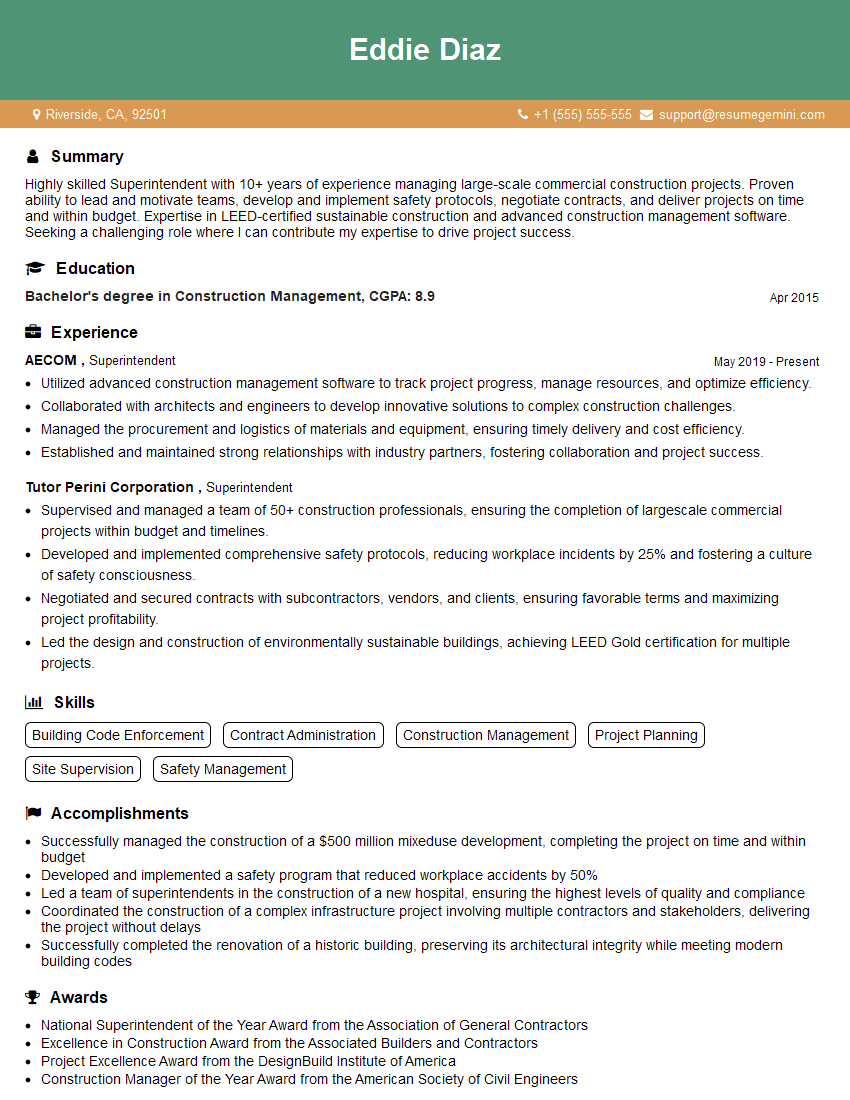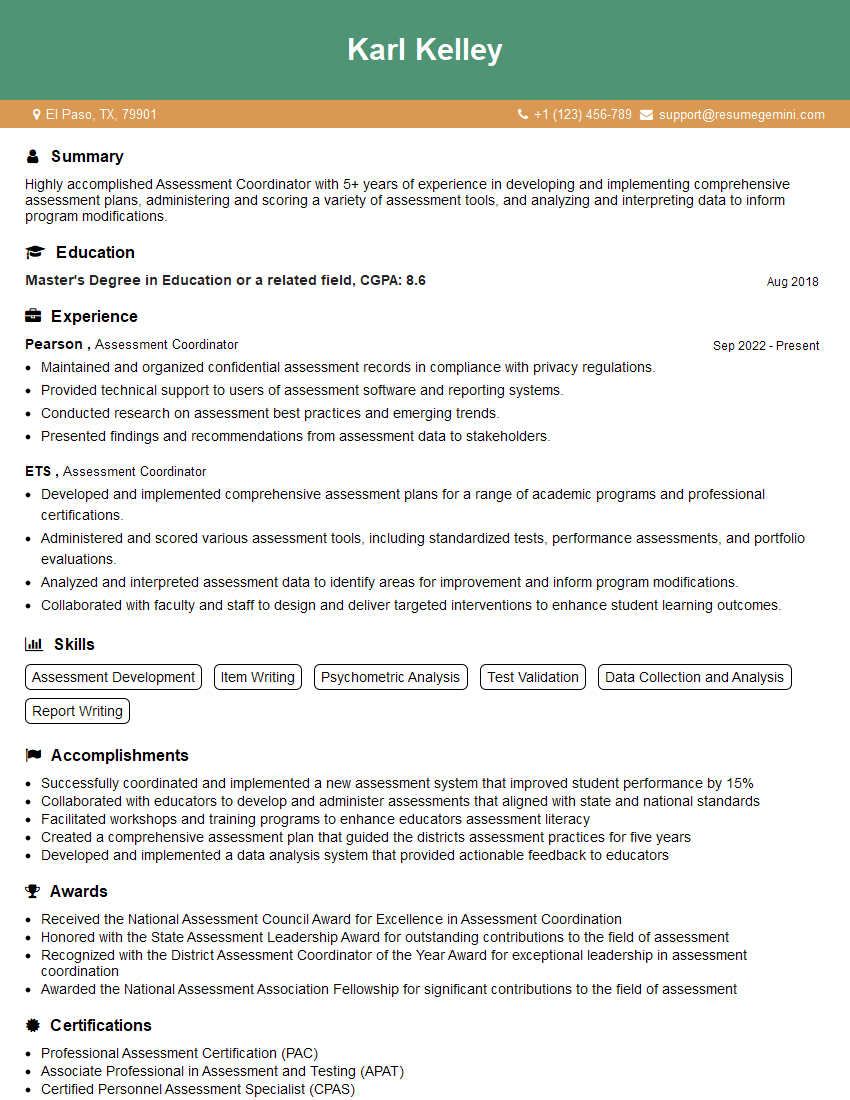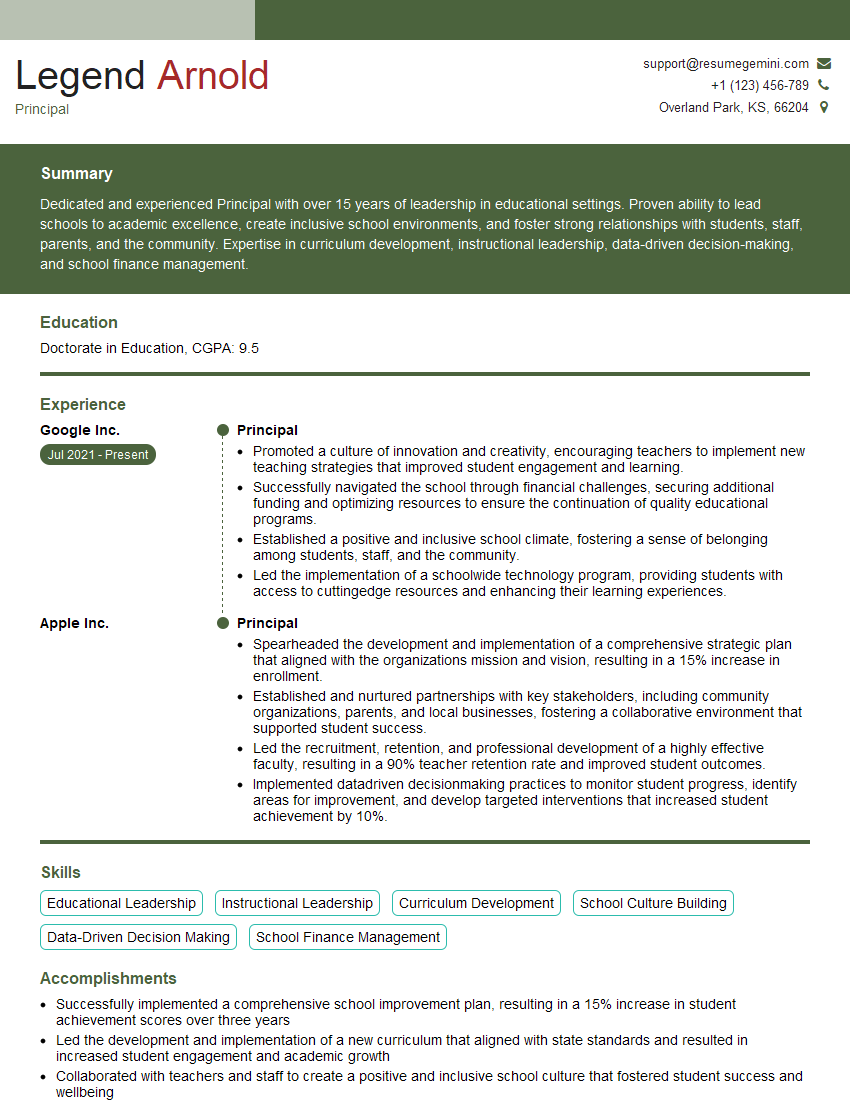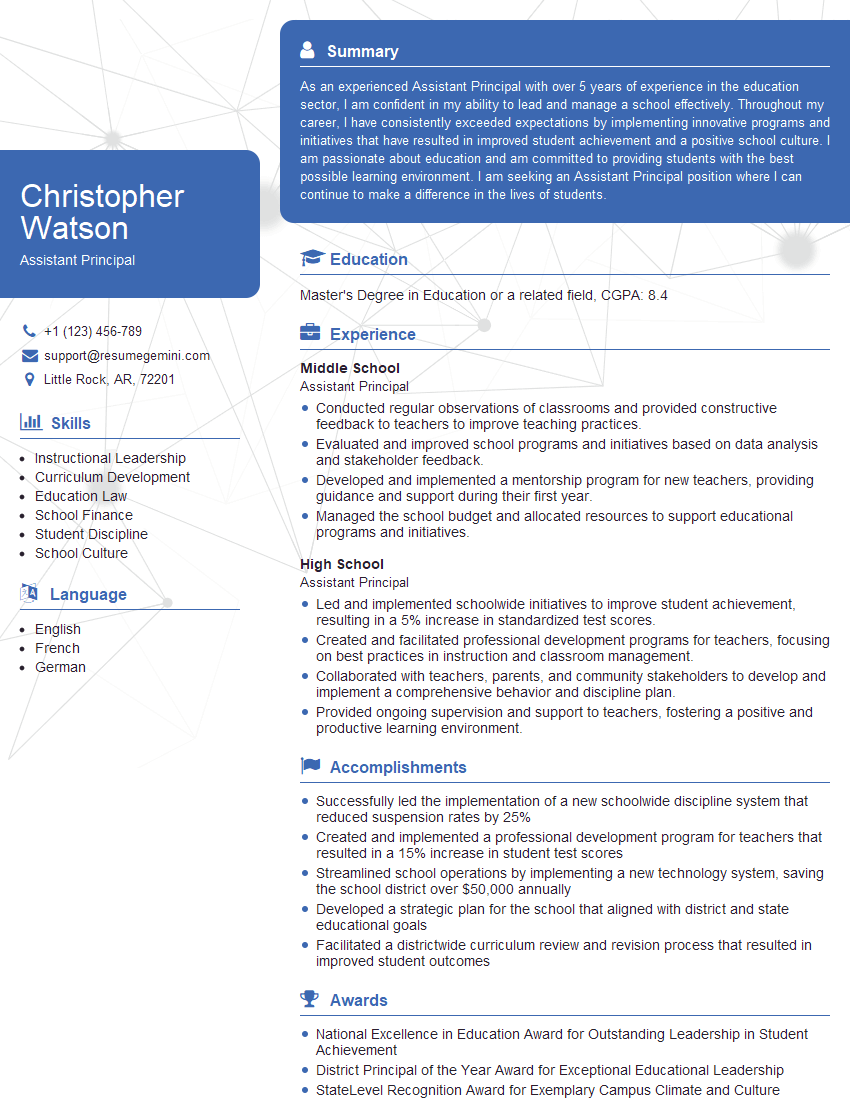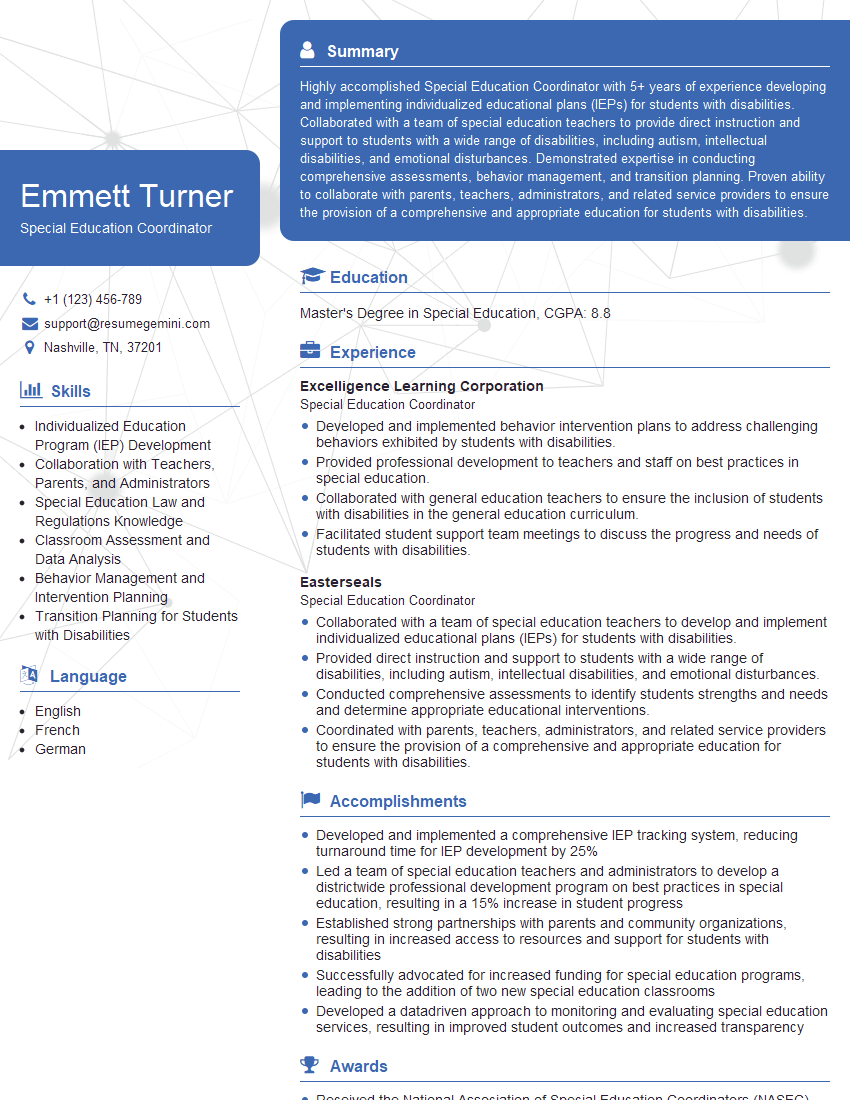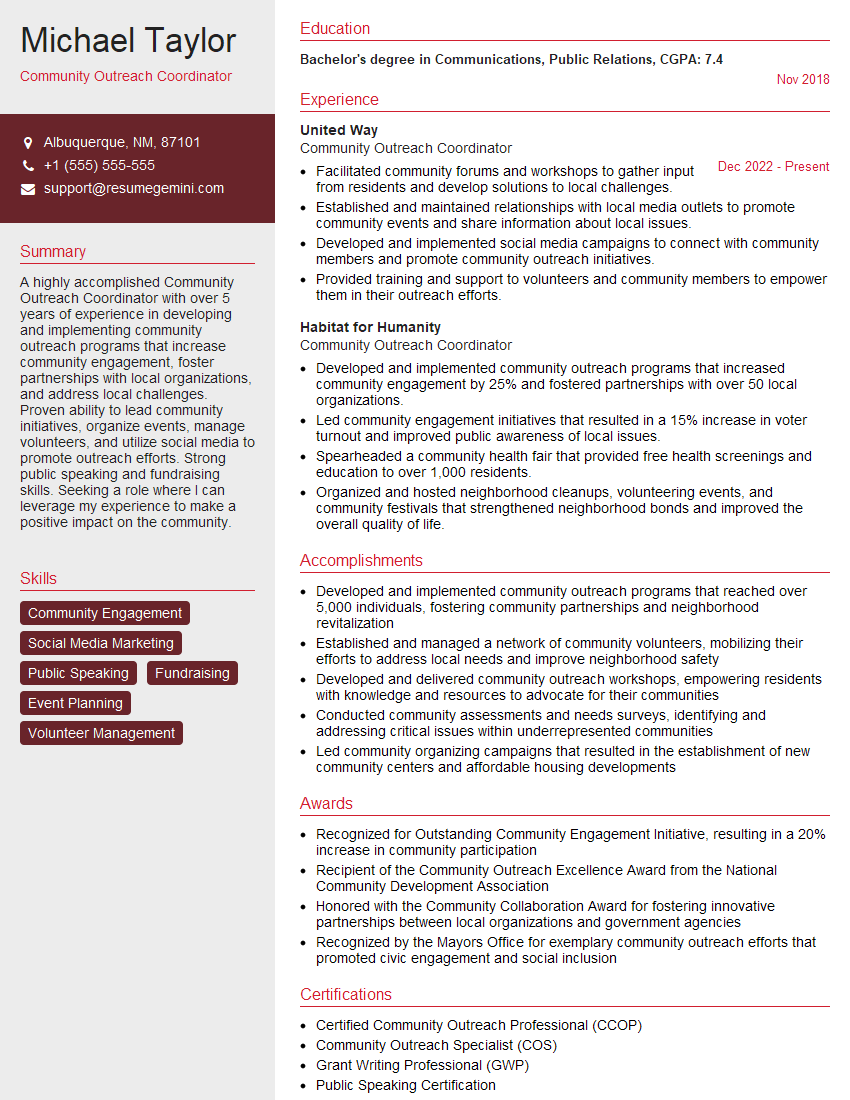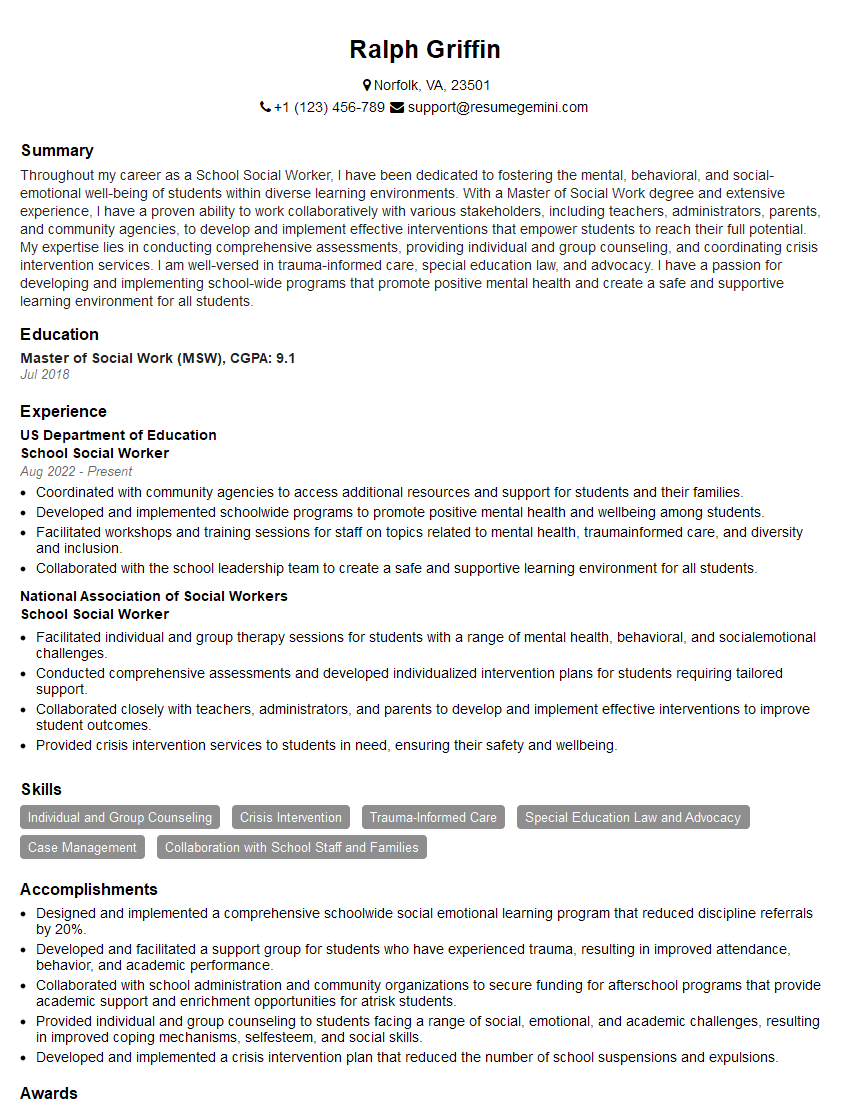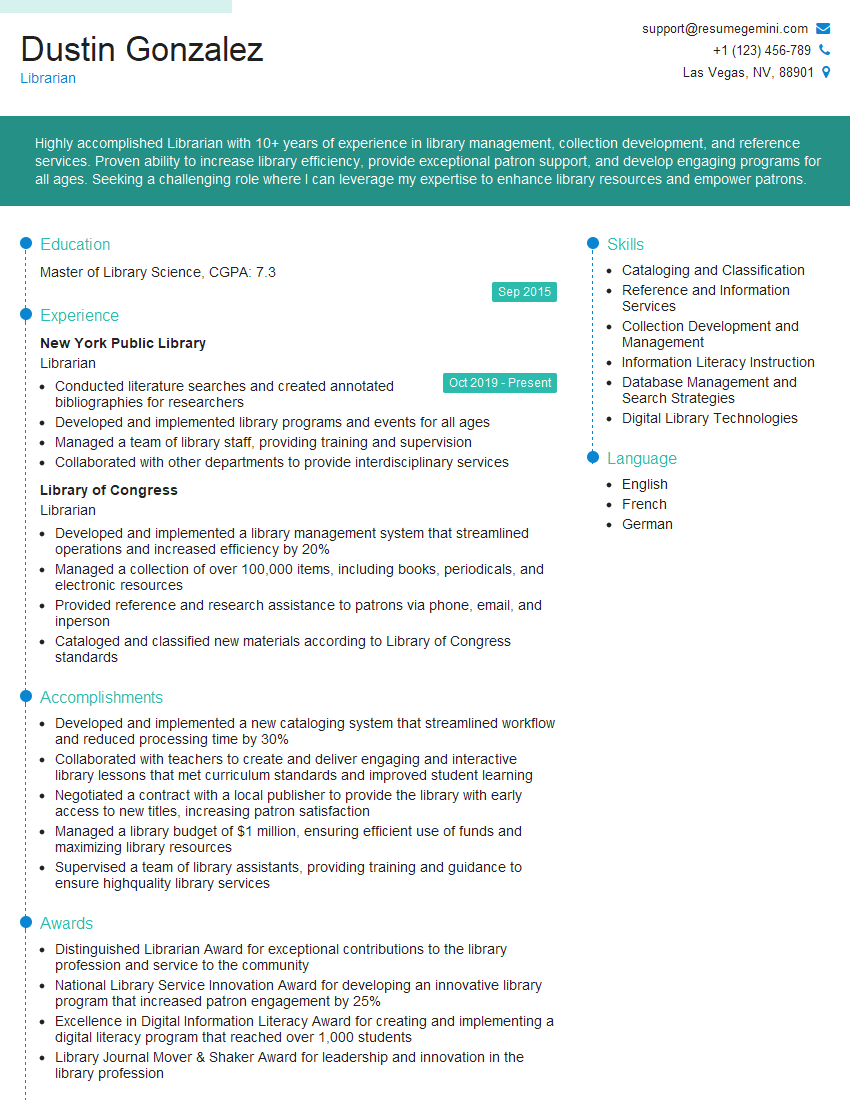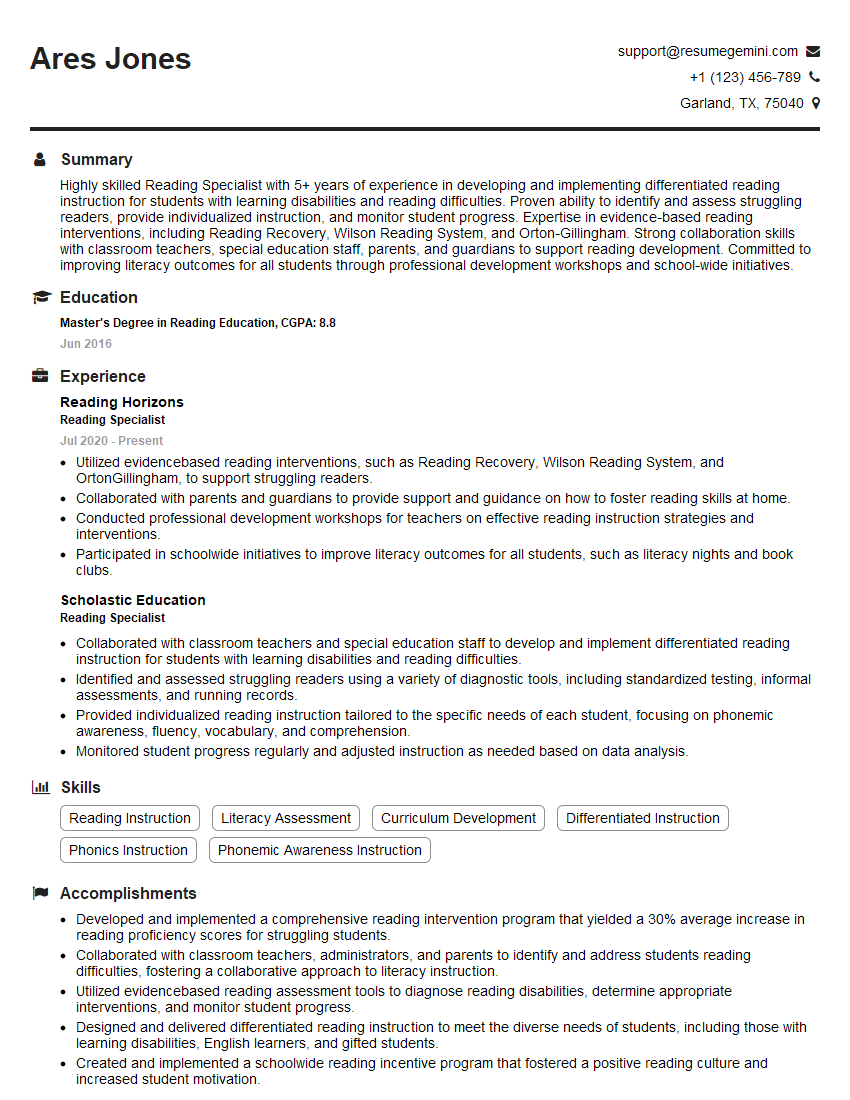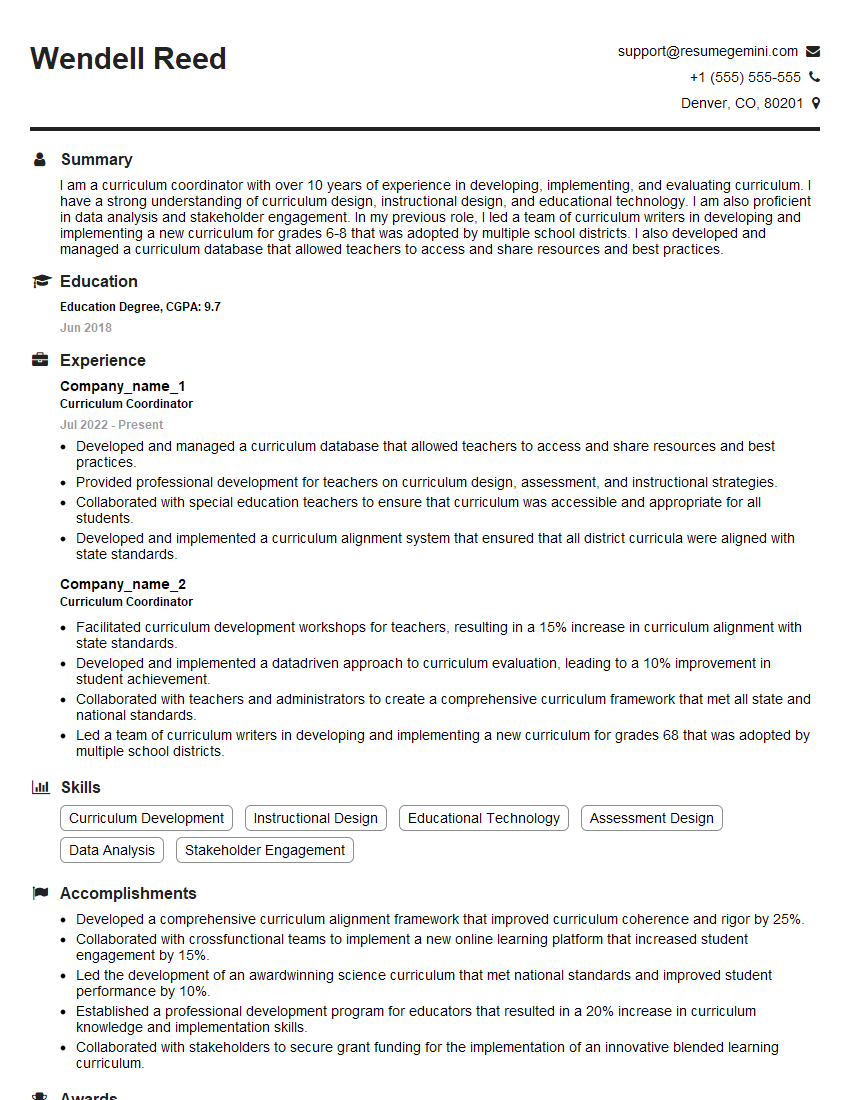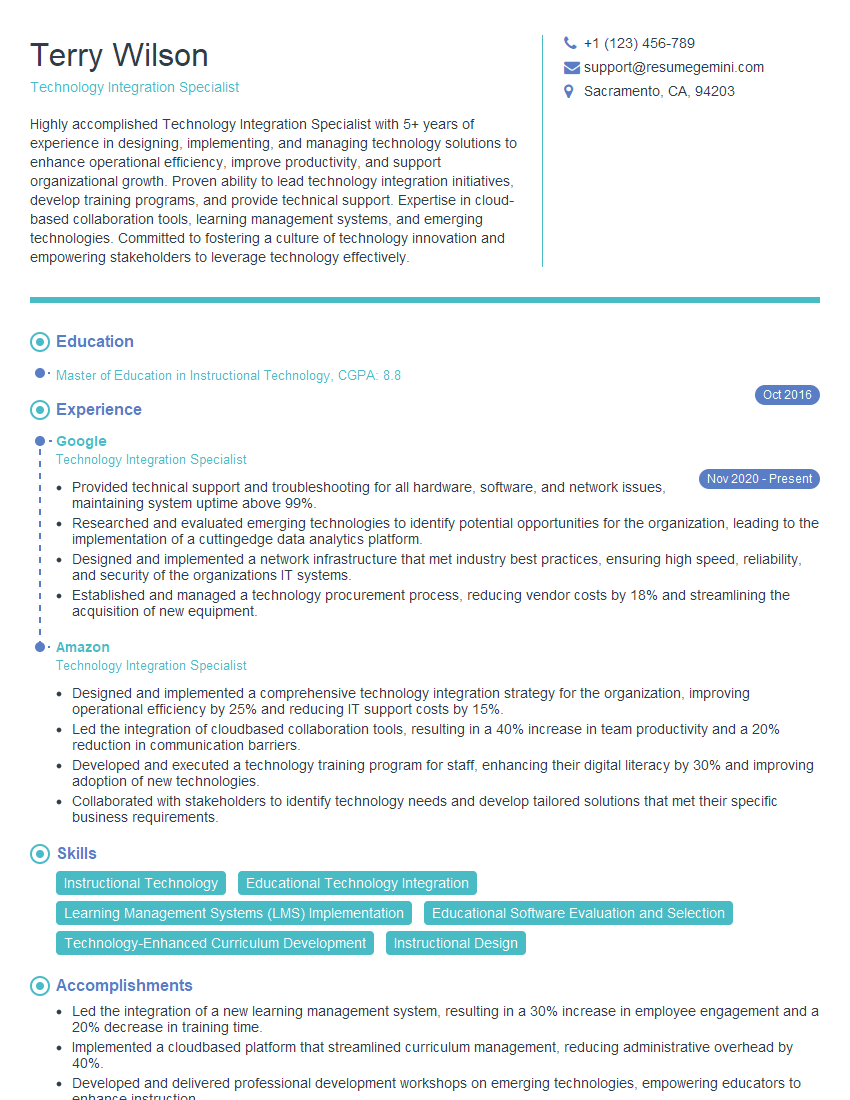The thought of an interview can be nerve-wracking, but the right preparation can make all the difference. Explore this comprehensive guide to Collaboration with Teachers and School Personnel interview questions and gain the confidence you need to showcase your abilities and secure the role.
Questions Asked in Collaboration with Teachers and School Personnel Interview
Q 1. Describe your experience fostering collaborative relationships with teachers.
Fostering collaborative relationships with teachers requires a multifaceted approach centered around trust, open communication, and mutual respect. It’s about creating a shared vision and empowering teachers to feel valued and heard.
In my experience, I’ve found that regular, informal meetings – perhaps over coffee or during non-instructional time – are invaluable for building rapport. These casual conversations allow teachers to voice concerns, share ideas, and feel comfortable approaching me with challenges. I also actively participate in professional learning communities (PLCs), facilitating discussions, and providing guidance on shared instructional goals. This allows for collective problem-solving and the development of best practices. Finally, I consistently provide constructive feedback, both positive reinforcement and targeted suggestions for improvement, delivered in a supportive and encouraging manner. For example, when a teacher implemented a new strategy that showed initial success, I celebrated their initiative and provided additional resources to enhance their method. Conversely, when a teacher was struggling with a specific aspect of their instruction, I offered one-on-one coaching and access to relevant professional development.
Q 2. How do you facilitate effective communication between teachers and administrators?
Effective communication between teachers and administrators hinges on establishing clear, transparent channels and fostering a culture of open dialogue. This isn’t a one-way street; it’s about actively listening to teachers’ concerns and perspectives as much as it is about conveying information.
I facilitate this through various methods: regular staff meetings with structured agendas allowing for teacher input, utilizing email and school communication platforms to disseminate information swiftly and efficiently, and holding individual or small group meetings to address specific concerns. For instance, I’ve established a monthly ‘Teacher Forum’ where teachers can raise issues or suggest improvements in a safe and respectful space. This open forum contributes significantly to transparency and reduces the likelihood of misunderstandings. I also utilize surveys and feedback mechanisms to gather teacher perspectives on policies, procedures, and school-wide initiatives. Analyzing this feedback helps me to tailor communication strategies to be more effective and relevant.
Q 3. Explain your approach to resolving conflicts between teachers.
My approach to resolving conflicts between teachers prioritizes mediation and focuses on finding mutually acceptable solutions. It’s crucial to remain impartial and create a safe space where teachers feel comfortable expressing their perspectives without fear of judgment.
My process typically involves individually meeting with each involved teacher to understand their perspectives and concerns. I then facilitate a joint meeting, focusing on active listening and encouraging respectful communication. The goal isn’t to assign blame but to collaboratively identify the root cause of the conflict and develop solutions. For example, if a disagreement arose about classroom resource allocation, I would guide them to find a compromise that ensures fair distribution based on the needs of their students. Documentation of the conflict resolution process, including agreed-upon solutions and timelines, is also crucial for ensuring accountability and preventing future recurrences.
Q 4. How have you supported teachers in implementing new curriculum initiatives?
Supporting teachers in implementing new curriculum initiatives requires a comprehensive strategy that combines professional development, mentorship, and ongoing support. It’s about providing the tools, training, and encouragement teachers need to feel confident and capable.
I typically begin by organizing professional development workshops tailored to the specific needs of the new curriculum. This might include interactive sessions, model lessons, and collaborative planning time. I also establish a mentorship program, pairing experienced teachers with those new to the curriculum. This provides ongoing support and a valuable opportunity for peer-to-peer learning. Furthermore, I ensure consistent access to resources, including online materials, relevant research, and updated instructional guides. Providing opportunities for teachers to share their experiences and challenges in a supportive environment through regular check-ins, informal gatherings, and PLCs, further enhances their implementation success. For example, when implementing a new technology-based curriculum, I organized workshops that covered the technology itself and offered individualized coaching sessions for those teachers who needed additional support.
Q 5. Describe a time you mentored a new teacher. What strategies did you use?
I recently mentored a new teacher who was struggling to manage classroom behavior. My strategy involved a combination of observation, coaching, and collaborative planning.
First, I observed her classroom several times to identify specific challenges and strengths. Then, I provided feedback that focused on specific, actionable strategies, such as implementing clear classroom rules and procedures. We also collaboratively planned lessons, using evidence-based teaching strategies to address the behavioral issues. Finally, I offered regular check-ins, both formal and informal, to provide ongoing support and guidance. The collaboration involved co-developing strategies, role-playing various classroom scenarios and reviewing student work together. Through this process, the new teacher gained confidence in her classroom management skills and developed effective strategies that positively impacted her students’ learning environment.
Q 6. How do you ensure all school personnel are informed of important updates and changes?
Ensuring all school personnel are informed requires a multi-channel approach that leverages various communication tools and techniques. It’s essential to use a variety of methods to cater to different learning styles and preferences and to ensure that information reaches everyone.
My strategy incorporates regular staff meetings, email announcements, school newsletters (both digital and physical), a dedicated school website and communication platform with announcements and updates, and even text message alerts for urgent matters. Information is consistently presented in multiple formats, incorporating visual aids, concise summaries, and Q&A sessions to foster clarity and understanding. Regular feedback mechanisms are used to assess the effectiveness of communication strategies and to make adjustments as necessary. For example, I’ve created a school-wide online calendar that displays upcoming events, deadlines, and professional development opportunities to keep staff informed and organized.
Q 7. What strategies do you employ to build a positive and supportive school culture?
Building a positive and supportive school culture is a continuous process that involves fostering a sense of community, celebrating successes, and addressing challenges proactively. It’s about creating an environment where everyone feels valued, respected, and empowered.
My strategies include implementing school-wide recognition programs to celebrate achievements, both academic and personal. This can be through assemblies, newsletters, or even simple notes of appreciation. I encourage collaboration between staff members through team-building activities and shared professional development opportunities. I also establish clear expectations for behavior and conduct, ensuring that they are consistently applied and reinforced. Furthermore, creating opportunities for social interaction, such as staff social events or informal gatherings, helps build relationships and fosters a stronger sense of community. By actively promoting open communication, addressing conflicts fairly, and fostering a climate of respect and understanding, a positive and supportive school culture that benefits all stakeholders can be achieved.
Q 8. How do you identify and address teacher burnout or morale issues?
Identifying and addressing teacher burnout and morale issues requires a multifaceted approach focusing on both individual well-being and systemic factors. It starts with open communication and creating a safe space for teachers to share their concerns. Regular informal check-ins, both individually and in team meetings, are crucial. Active listening is paramount; I aim to understand the root causes of their stress, whether it’s excessive workload, lack of resources, challenging student behaviors, or feeling undervalued.
Strategies I utilize include:
- Anonymous surveys and feedback mechanisms: These help gather data on prevalent issues without fear of retribution. I’ve found that using platforms like SurveyMonkey allows for easy data analysis and the identification of recurring themes.
- Focus groups and individual interviews: These provide deeper insights into individual experiences and perspectives. I always ensure a comfortable and confidential environment.
- Implementing workload management strategies: This might involve re-evaluating lesson plans, streamlining administrative tasks, or implementing collaborative planning sessions to distribute responsibilities more evenly.
- Providing access to mental health resources and professional development on stress management techniques: This is crucial for equipping teachers with coping mechanisms and ensuring they know they’re supported. I’ve successfully partnered with local mental health organizations to offer workshops and individual counseling sessions.
- Celebrating successes and acknowledging contributions: Publicly acknowledging achievements boosts morale significantly. I regularly highlight teacher accomplishments during staff meetings and school events.
For example, in my previous role, we noticed a high level of stress related to grading. By implementing a school-wide grading policy that emphasized formative assessment and reduced the reliance on high-stakes summative tests, we saw a significant improvement in teacher morale and a reduction in burnout.
Q 9. Describe your experience with data-driven decision-making in collaboration with teachers.
Data-driven decision-making is fundamental to effective school leadership. My experience involves using various data sources, including student achievement data (standardized test scores, classroom assessments), attendance records, discipline data, and teacher feedback surveys, to inform strategic planning and resource allocation. I work collaboratively with teachers to analyze this data, interpret its implications, and develop action plans.
For instance, if student performance data reveals a significant gap in a specific subject area, I wouldn’t simply assign extra work. Instead, I’d convene a team of teachers to analyze the data, discuss potential contributing factors (e.g., curriculum gaps, teaching methods, student needs), and collaboratively brainstorm and implement targeted interventions, such as professional development focused on specific instructional strategies or the implementation of new learning materials.
This process requires transparency and shared ownership. I ensure teachers understand the data, its limitations, and how it informs decisions. I facilitate data analysis workshops to equip teachers with the skills needed to interpret the information themselves. The goal is empowerment—not a top-down imposition of directives.
Q 10. How do you use data to inform instructional practices and support teacher growth?
Data informs instructional practices and supports teacher growth by providing objective evidence of student learning and identifying areas needing improvement. I utilize data to identify effective teaching strategies and pinpoint areas where adjustments are needed. For example, if data shows that students struggle with a particular concept, we might analyze teaching materials, student work samples, and teacher lesson plans to identify the source of the difficulty.
Specific strategies I employ include:
- Regular data analysis meetings: These meetings provide a platform for teachers to share their classroom data, discuss student performance, and collaboratively plan for improvement.
- Using data to inform professional development: I ensure that professional development opportunities address specific needs revealed through data analysis. If data indicates a need for improvement in a particular skill area (e.g., differentiated instruction), professional development workshops are targeted to address that need.
- Mentoring and coaching programs: Pairing experienced teachers with newer educators, using data as a framework for instructional discussions and goal-setting.
- Providing individualized feedback: This involves analyzing individual teacher data to identify strengths and areas for improvement, providing constructive feedback, and developing personalized professional growth plans.
For example, I’ve supported teachers in implementing a new reading intervention program based on data showing low reading comprehension scores. We tracked student progress using the program’s built-in assessment tools, and used the data to adjust the program’s implementation as needed, leading to measurable improvement in student reading scores.
Q 11. How do you involve parents and the community in school initiatives?
Involving parents and the community in school initiatives is crucial for building a strong school culture and fostering student success. I believe in a collaborative partnership where parents and community members are active participants, not just recipients of information. My approach emphasizes open communication, transparency, and shared responsibility.
Strategies I’ve used successfully include:
- Regular parent-teacher conferences and communication channels: These provide opportunities for open dialogue and feedback.
- Parent volunteer programs: Involving parents in classroom activities, school events, and administrative tasks creates a sense of ownership and collaboration.
- Community partnerships: Collaborating with local organizations to provide resources and opportunities for students and families.
- School events and open houses: Creating opportunities for parents and community members to engage with the school and learn about its initiatives.
- Parent education workshops: Providing resources and information to support parents in their children’s education.
For example, we partnered with a local library to create a family reading program, boosting literacy among students and encouraging family engagement in learning. This collaborative effort demonstrated the significant positive impact of uniting the school, parents, and the wider community.
Q 12. How do you ensure equity and inclusion in collaborative efforts with teachers?
Ensuring equity and inclusion in collaborative efforts requires a conscious and proactive approach. It’s about creating an environment where all voices are heard, valued, and respected, and where all individuals feel a sense of belonging. This involves actively addressing systemic biases and fostering a culture of empathy and understanding.
My strategies focus on:
- Culturally responsive teaching practices: Providing professional development opportunities for teachers to learn about culturally responsive teaching and how to adapt their instruction to meet the diverse needs of all students.
- Equitable distribution of resources: Ensuring that all students, regardless of their background or needs, have access to the resources they need to succeed.
- Inclusive curriculum development: Working with teachers to develop a curriculum that reflects the diversity of our student population and promotes social justice.
- Addressing bias in assessment and evaluation: Using assessment methods that are fair and equitable, and that avoid perpetuating stereotypes and biases.
- Creating a safe and welcoming environment: Fostering a school culture where all students feel safe, respected, and valued.
For example, we implemented a restorative justice program to address conflict and promote positive relationships, which directly improved equity and inclusion throughout the school.
Q 13. What professional development opportunities have you provided or supported for teachers?
I’ve provided and supported a range of professional development opportunities tailored to teachers’ individual needs and school-wide goals. My approach is data-driven and focuses on continuous improvement. We regularly assess teacher needs through surveys, observations, and feedback sessions.
Types of professional development I’ve offered include:
- Workshops and seminars on specific instructional strategies: These address identified needs, such as differentiated instruction, using technology effectively, or specific subject-matter pedagogy.
- Mentoring and coaching programs: Pairing experienced teachers with newer educators to provide ongoing support and guidance.
- Professional learning communities (PLCs): Facilitating collaborative learning groups where teachers can share best practices, discuss challenges, and work together to improve student outcomes.
- Access to online resources and professional learning platforms: Providing teachers with access to a wide range of resources to support their professional growth. I’ve successfully used platforms offering micro-learning and online courses.
- Conferences and external training: Sending teachers to relevant professional conferences and training sessions to broaden their knowledge and skills.
For example, in response to data indicating a need for improvement in using technology in the classroom, we organized a series of workshops focused on integrating technology into different subject areas, resulting in a measurable increase in technology integration across the school.
Q 14. Describe your experience with collaborative planning and curriculum development.
Collaborative planning and curriculum development are essential for creating a coherent and effective educational program. My approach is deeply collaborative, ensuring that teachers are active participants in the process. This isn’t just about creating a curriculum document; it’s about building a shared vision and understanding.
My experience includes:
- Facilitating curriculum mapping workshops: These workshops involve teachers from various grade levels and subjects to align curriculum goals and standards, ensuring a logical progression of learning across the years.
- Developing common assessments: Creating assessments that align with curriculum goals and provide consistent measures of student learning across classrooms.
- Establishing clear learning objectives and standards: Ensuring that all teachers understand and agree on the learning goals for each grade level and subject area.
- Encouraging peer observation and feedback: Creating opportunities for teachers to observe each other’s classrooms, share best practices, and provide constructive feedback.
- Utilizing data to inform curriculum decisions: Using student assessment data to identify areas where curriculum needs revision or improvement.
For example, we recently redesigned our math curriculum through a collaborative effort involving all math teachers. This collaborative process not only yielded a more effective and engaging math program but also fostered a stronger sense of shared purpose and professional collaboration among the teaching staff.
Q 15. How do you use technology to enhance teacher collaboration and communication?
Technology significantly boosts teacher collaboration and communication. Think of it as upgrading from handwritten notes to a streamlined, efficient system. We leverage platforms like Google Workspace (including Docs, Slides, and Meet) for real-time document collaboration, shared lesson planning, and virtual meetings. This allows for asynchronous work (teachers can contribute at their own pace) and synchronous collaboration (real-time discussions and brainstorming). For instance, we might use a shared Google Doc to collaboratively create unit plans, with each teacher responsible for a specific section. Google Meet facilitates quick check-ins, department meetings, and even professional development sessions. Secure messaging platforms like Remind allow for quick announcements and private conversations between teachers and staff. Learning Management Systems (LMS) like Canvas or Moodle are crucial for sharing resources, tracking student progress, and facilitating communication with parents. Using these tools not only streamlines workflows but also fosters a more connected and supportive professional learning community.
Career Expert Tips:
- Ace those interviews! Prepare effectively by reviewing the Top 50 Most Common Interview Questions on ResumeGemini.
- Navigate your job search with confidence! Explore a wide range of Career Tips on ResumeGemini. Learn about common challenges and recommendations to overcome them.
- Craft the perfect resume! Master the Art of Resume Writing with ResumeGemini’s guide. Showcase your unique qualifications and achievements effectively.
- Don’t miss out on holiday savings! Build your dream resume with ResumeGemini’s ATS optimized templates.
Q 16. How do you manage diverse teaching styles and preferences within a collaborative team?
Managing diverse teaching styles within a collaborative team requires a thoughtful, inclusive approach. It’s like conducting an orchestra – each musician plays their instrument differently, yet contributes to a harmonious whole. We begin by establishing clear communication protocols and expectations. This includes defining roles and responsibilities within the team. For instance, one teacher might excel at designing engaging activities, while another is a master at differentiating instruction. We explicitly acknowledge and celebrate these strengths. Regular professional learning communities (PLCs) provide a platform for teachers to share their approaches and learn from one another. We use structured collaborative planning time, dedicated to developing shared understanding and lesson alignment. We encourage active listening and respectful dialogue. Conflict resolution strategies are proactively introduced and practiced, creating a safe space to discuss differences. The goal is not to force conformity, but to create a supportive environment where diverse perspectives enhance the learning experience for all students.
Q 17. Describe your experience with co-teaching or team teaching models.
I have extensive experience with both co-teaching and team-teaching models. Co-teaching involves two teachers sharing responsibility for a single classroom, often with clearly defined roles (one teacher leads instruction, while the other provides support or differentiated instruction). In one instance, I co-taught a high school English class with a colleague. I focused on delivering direct instruction, while my colleague circulated the room, providing individual support and addressing student misconceptions. This model allowed us to effectively cater to diverse learning needs within a single classroom. Team teaching is more flexible, with teachers collaborating on curriculum development, instruction, and assessment but potentially teaching separate classes or groups. For example, my team worked collaboratively to design a thematic unit across several subjects. Each team member taught their specialized subject within the thematic framework, leading to a more integrated and meaningful learning experience for students. Both models require strong communication, mutual respect, and a shared vision for student success. The key is to establish clear expectations and roles from the outset.
Q 18. How do you ensure that all staff members feel valued and respected in collaborative settings?
Creating a collaborative environment where everyone feels valued is paramount. It’s about fostering a sense of belonging and shared purpose. We start by actively soliciting input from all staff members. Regular staff meetings provide opportunities for open dialogue and feedback. We create opportunities for teachers to showcase their expertise and share their ideas, such as leading workshops or presenting their work at staff meetings. We implement systems for recognizing and appreciating contributions – be it a small thank you note, public acknowledgment at a school meeting, or a formal recognition program. Active listening is essential. We make an effort to understand each staff member’s perspective and concerns. We address issues of inequity and bias proactively, promoting inclusive practices and fostering a culture of respect. By ensuring that everyone’s voice is heard and valued, we cultivate a collaborative spirit that strengthens the entire school community.
Q 19. What are some common challenges in teacher collaboration, and how do you overcome them?
Common challenges in teacher collaboration include scheduling conflicts, differing teaching philosophies, personality clashes, and lack of shared vision. Overcoming these requires proactive measures. Scheduling conflicts are addressed through careful planning and flexible scheduling arrangements. Differing teaching philosophies can be navigated through respectful dialogue and finding common ground in student learning outcomes. Personality clashes are managed through mediation and conflict-resolution strategies, focusing on building mutual understanding and respect. Establishing a shared vision is crucial, and this is achieved through collaborative goal-setting and open communication. We emphasize the importance of shared professional development opportunities to align practices and foster a sense of collective efficacy. Regular team meetings with clearly defined agendas provide a structured environment to discuss challenges and find solutions. Ultimately, successful collaboration is built on trust, open communication, and a commitment to a shared goal – student success.
Q 20. Describe a time you successfully navigated a difficult collaboration with a resistant teacher.
I once worked with a teacher resistant to collaborative planning. She preferred working independently and felt collaborative efforts were time-consuming. My approach involved building a relationship with her first. I started by acknowledging her expertise and her preference for independent work. Instead of forcing collaboration, I offered choices. I suggested small, manageable collaborative projects, focusing on specific aspects of her teaching where she might find value in shared perspectives, such as lesson preparation for struggling students. I emphasized the benefits of collaboration for her students, highlighting how shared resources and diverse approaches could enhance their learning experience. Gradually, she became more comfortable and involved in collaborative work. This success demonstrates the importance of patience, empathy, and finding common ground, rather than imposing collaboration. It’s crucial to recognize individual needs and preferences while encouraging collaboration in a way that feels supportive rather than coercive.
Q 21. How do you measure the success of collaborative efforts within the school?
Measuring the success of collaborative efforts requires a multifaceted approach. We use both quantitative and qualitative measures. Quantitative measures include analyzing student achievement data across classrooms involved in collaborative projects. For instance, we compare pre- and post-test scores, student project grades, and overall class performance. We also track teacher participation rates in collaborative activities, such as attendance at PLCs and engagement in shared planning sessions. Qualitative measures focus on gathering feedback through teacher surveys, observations of collaborative practices, and interviews to assess the overall impact on teacher morale, job satisfaction, and the overall collaborative culture. We gather student feedback to gauge their perception of the quality of instruction resulting from the collaborative efforts. By combining both quantitative and qualitative data, we gain a comprehensive understanding of the effectiveness and impact of our collaborative initiatives on both teachers and students.
Q 22. How do you ensure teacher voice is heard and valued in decision-making processes?
Ensuring teacher voice is paramount for a thriving school environment. It’s not just about hearing teachers; it’s about actively seeking their input and integrating it into meaningful decision-making. This involves creating multiple avenues for their participation.
- Formal Structures: Establishing regular teacher forums, committees, or councils where teachers can voice concerns, share ideas, and participate in collaborative planning. For example, a curriculum committee composed of teachers representing different grade levels and subject areas can collaboratively design and review the school’s curriculum.
- Informal Channels: Creating opportunities for informal feedback, such as regular informal coffee chats with administration, open-door policies, and anonymous suggestion boxes. For instance, a weekly ‘Teacher’s Corner’ during staff meetings, where teachers can briefly share successes, challenges, or suggestions.
- Surveys and Feedback Mechanisms: Utilizing surveys, online polls, or feedback forms to gather broad input on specific issues or initiatives. Examples include using online survey tools to assess teacher satisfaction with professional development opportunities or collecting feedback on new classroom technologies.
- Data-Driven Decision Making: Using student achievement data to inform discussions about instructional strategies. This empowers teachers by making their classroom practices central to the decision-making process and showing that their expertise is valuable.
Crucially, it’s about demonstrating that feedback is actively considered and acted upon. Transparency in the decision-making process, explaining how teacher input influenced choices, builds trust and encourages future participation.
Q 23. Describe your experience in facilitating meetings and workshops for teachers and staff.
I have extensive experience facilitating meetings and workshops, employing a variety of techniques to ensure inclusive and productive sessions. I prioritize creating a safe and respectful environment where all participants feel comfortable sharing their thoughts and ideas.
- Structured Agenda: I always begin with a clearly defined agenda distributed in advance, ensuring everyone knows the purpose and expected outcomes of the meeting. This allows for efficient time management and keeps discussions focused.
- Collaborative Brainstorming: I utilize various collaborative brainstorming techniques, such as mind mapping or round-robin discussions, to encourage diverse perspectives and creative problem-solving. This helps to involve all participants and foster a sense of shared ownership.
- Active Listening and Facilitation: I focus on active listening, summarizing key points to ensure understanding and managing discussions to ensure everyone has a chance to contribute. I also use visual aids to keep the group focused and present information clearly.
- Constructive Feedback Mechanisms: I create opportunities for feedback on the meeting itself to improve future sessions. This ensures that the process is continually refined to best serve the participants. For example, anonymous feedback forms help collect data to inform improvements to future sessions.
My goal is always to transform meetings from passive information-sharing events into collaborative problem-solving sessions, resulting in actionable outcomes and a stronger sense of community among the teaching staff.
Q 24. How do you provide constructive feedback to teachers in a supportive and collaborative manner?
Providing constructive feedback is an art. It’s about focusing on observable behaviors and their impact, offering specific suggestions for improvement, and fostering a growth mindset. I always frame feedback within a supportive and collaborative context.
- Focus on Specific Examples: Instead of general statements, I provide concrete examples of both strengths and areas for growth. For instance, “Your use of questioning techniques in yesterday’s lesson effectively engaged students, particularly the strategy of asking open-ended questions.” or “While your lesson plan was comprehensive, focusing on one learning objective at a time might improve student comprehension.”
- Collaborative Dialogue: I encourage a two-way conversation, not a one-way lecture. I ask teachers for their perspectives and invite them to share their thoughts on the observed areas for improvement. This collaborative approach empowers teachers and enhances their ownership of the feedback process.
- Goal-Oriented Feedback: I link feedback to specific goals and objectives, aligning it with the teacher’s professional development plan or school-wide improvement goals. This ensures that the feedback is relevant and impactful, focusing on areas where the teacher is aiming to improve.
- Strengths-Based Approach: I always begin by highlighting the teacher’s strengths before discussing areas for growth. This positive reinforcement builds confidence and creates a receptive environment for receiving constructive criticism.
The overall aim is to create a culture of continuous improvement where feedback is viewed as a tool for professional growth, rather than a judgment of performance.
Q 25. What is your approach to building trust and rapport with teachers and school personnel?
Building trust and rapport is fundamental to effective collaboration. It requires consistent effort, active listening, and demonstrating genuine respect for teachers’ expertise and contributions.
- Open Communication: Maintaining open and honest communication channels, encouraging teachers to express their opinions without fear of reprisal. This builds a sense of psychological safety within the team.
- Active Listening and Empathy: Demonstrating genuine interest in teachers’ perspectives, challenges, and concerns, fostering empathy by actively seeking to understand their unique situations and needs.
- Collaboration and Shared Decision-Making: Involving teachers in decision-making processes, demonstrating that their opinions matter and are valued by seeking their input on significant issues.
- Respect and Professionalism: Treating teachers with respect, acknowledging their hard work and dedication, and appreciating the complexity of their roles.
- Building Relationships: Taking the time to get to know teachers on a personal level, demonstrating genuine interest in their professional and personal lives, creating opportunities for informal social interaction.
Trust is built over time through consistent actions and genuine care. By consistently demonstrating reliability and respect, strong working relationships will naturally flourish.
Q 26. How do you support teachers in using differentiated instruction strategies?
Supporting teachers in using differentiated instruction is crucial for meeting the diverse needs of all learners. This involves providing them with the knowledge, skills, and resources they need to adapt their teaching to individual student learning styles and needs.
- Professional Development: Offering targeted professional development workshops and training sessions focused on various differentiated instruction strategies such as tiered assignments, flexible grouping, and learning centers.
- Modeling and Coaching: Providing opportunities for teachers to observe differentiated instruction in action through classroom demonstrations, peer observations, and mentoring programs. Active coaching during lesson implementation provides real-time support and feedback.
- Resource Sharing: Providing teachers with access to a variety of resources, such as lesson plans, assessment tools, and technology platforms, that support differentiated instruction practices. Examples include curated collections of online resources, shared lesson plans, and access to assistive technology tools.
- Collaboration and Peer Support: Creating opportunities for teachers to collaborate with colleagues and share best practices in differentiated instruction. This can be facilitated through peer observations, lesson study groups, or collaborative planning sessions.
- Data-Driven Decision Making: Using student assessment data to inform adjustments to instruction, ensuring that differentiation strategies are responsive to student progress and needs. This can involve regular data analysis meetings, formative assessments, and ongoing feedback loops.
Ultimately, the goal is to empower teachers to become skilled practitioners of differentiated instruction, able to effectively adapt their teaching to meet the unique needs of each student in their classroom.
Q 27. Describe your experience working with diverse student populations and adapting collaborative strategies accordingly.
Working with diverse student populations requires adapting collaborative strategies to address the unique cultural, linguistic, and learning needs of all students. This involves creating a culturally responsive and inclusive learning environment where all students feel valued and respected.
- Culturally Responsive Teaching: Integrating culturally relevant materials and teaching practices into instruction, valuing students’ diverse backgrounds and experiences. This might involve incorporating diverse perspectives into classroom readings, adapting teaching strategies to align with students’ cultural backgrounds, or creating culturally relevant projects.
- Language Support: Providing language support services, such as bilingual education or English as a Second Language (ESL) programs, to ensure that all students have access to instruction in their native language. This might involve incorporating translators, providing bilingual materials, or working with ESL specialists.
- Differentiated Instruction: Adapting teaching methods and materials to meet the individual learning needs of all students, using a variety of strategies to cater to diverse learning styles and preferences. This could involve using different learning modalities, providing varied levels of support, and using different assessment strategies.
- Family and Community Engagement: Engaging families and communities in the educational process, creating partnerships that support student success. This could involve establishing regular communication with families, inviting parents and community members to participate in school events, and building relationships with community organizations.
- Inclusive Classroom Management: Establishing classroom rules and procedures that are fair, equitable, and respectful of all students, creating a positive and supportive classroom environment where all students feel safe and included.
Collaboration with diverse populations requires flexibility, sensitivity, and a commitment to creating equitable opportunities for all learners. Building strong relationships with families and community members is paramount.
Q 28. How do you stay current with best practices in teacher collaboration and professional development?
Staying current with best practices is a continuous process. It requires active engagement with professional organizations, research, and ongoing professional development.
- Professional Organizations: Actively participating in professional organizations such as the National Education Association (NEA) or the Association for Supervision and Curriculum Development (ASCD), attending conferences and workshops, and engaging in online forums to learn about cutting-edge research and best practices in teacher collaboration and professional development.
- Educational Research: Regularly reviewing educational journals and research articles to stay abreast of the latest findings in the field of teacher collaboration and professional development. This includes identifying evidence-based practices and applying them in my work.
- Professional Development Opportunities: Engaging in professional development opportunities, such as workshops, seminars, and online courses, to expand my knowledge and skills in the area of teacher collaboration and professional development. This involves seeking out training and workshops that focus on improving collaboration strategies.
- Networking and Collaboration: Networking with other educational professionals through attending conferences, joining professional learning communities (PLCs), and engaging in online discussions to share best practices and learn from the experiences of others.
- Mentorship and Coaching: Seeking out opportunities for mentorship and coaching to enhance my skills and expertise in working with teachers and school personnel. This includes seeking feedback and support from more experienced professionals.
Continuous learning and adaptation are essential for remaining effective and responsive to the ever-evolving needs of teachers and students.
Key Topics to Learn for Collaboration with Teachers and School Personnel Interviews
- Understanding Diverse Learning Styles and Needs: Explore different teaching methodologies and how to adapt your communication and support strategies to meet the unique needs of individual students and teachers.
- Effective Communication and Active Listening: Practice clear, concise, and empathetic communication. Learn techniques for actively listening to understand perspectives and address concerns constructively.
- Building Positive Relationships and Trust: Discuss strategies for fostering collaborative partnerships based on mutual respect, open communication, and shared goals.
- Conflict Resolution and Problem-Solving: Explore techniques for identifying and addressing conflicts professionally and collaboratively, focusing on finding mutually beneficial solutions.
- Data-Driven Decision Making: Learn how to interpret and utilize student data to inform collaborative planning and interventions with teachers. This includes understanding assessment results and using data to track progress.
- Shared Goal Setting and Planning: Discuss the importance of collaborative goal setting and the process of developing and implementing effective plans with teachers to support student success.
- Utilizing Technology for Collaboration: Explore various platforms and tools that can facilitate effective communication and collaboration with teachers and school personnel (e.g., learning management systems, shared calendars, communication platforms).
- Advocacy for Students and Teachers: Understand the importance of advocating for the needs of both students and teachers within the school system.
Next Steps
Mastering collaboration with teachers and school personnel is crucial for career advancement in education and related fields. Strong collaborative skills demonstrate your ability to work effectively within a team, leading to increased job satisfaction and opportunities for leadership roles. To maximize your job prospects, create an ATS-friendly resume that highlights your relevant skills and experience. ResumeGemini is a trusted resource to help you build a professional resume that stands out. We provide examples of resumes tailored to showcasing experience in collaboration with teachers and school personnel to help you get started.
Explore more articles
Users Rating of Our Blogs
Share Your Experience
We value your feedback! Please rate our content and share your thoughts (optional).
What Readers Say About Our Blog
This was kind of a unique content I found around the specialized skills. Very helpful questions and good detailed answers.
Very Helpful blog, thank you Interviewgemini team.
